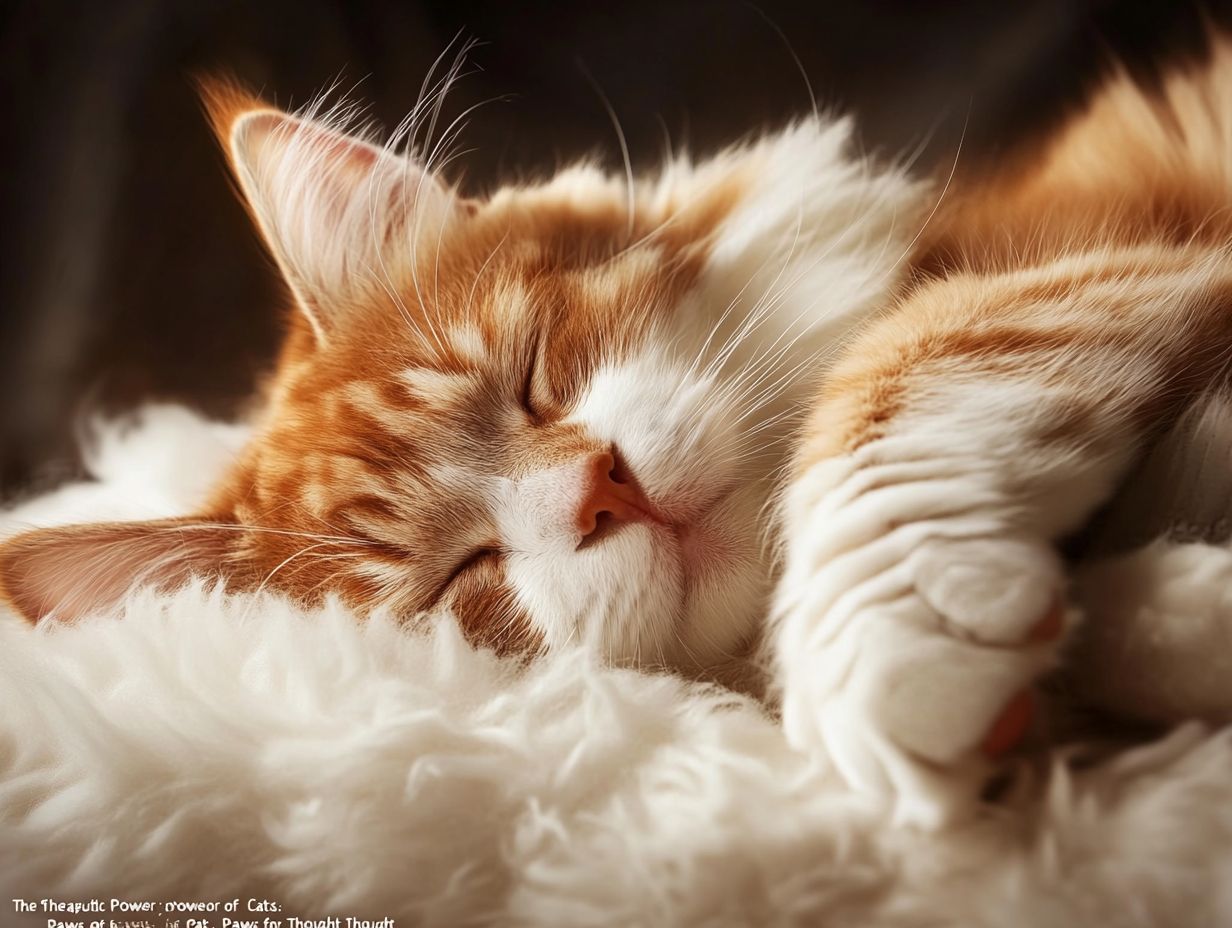Cats possess a remarkable ability to heal, providing more than mere companionship. This article delves into the therapeutic effects of feline friends, exploring various forms of cat therapy and their significant benefits for both physical and mental health.
You will learn how to effectively integrate cats into therapeutic practices, while ensuring the well-being of both the cats and the individuals they assist. Additionally, we will discuss the care and training required for therapy cats and highlight the potential for future research in this intriguing field.
Prepare to discover the healing power of our furry companions!
The Healing Power of Cats

The healing benefits of cats encompass numerous therapeutic advantages that enhance mental health and emotional well-being. Their soothing presence and playful behavior offer emotional support and help reduce stress levels for their owners.
The comforting sound of a cat’s purr has been scientifically proven to lower heart rates and blood pressure, illustrating the effectiveness of feline therapy for both physical and mental health.
The bond between humans and their feline companions underscores the idea that the essence of pet therapy lies in the relationship, which fosters care, positivity, and resilience.
Understanding the Therapeutic Effects
The therapeutic effects of cats are linked to their behaviors and presence, which provide anxiety reduction and emotional healing for their owners. Studies indicate that petting a cat can trigger the release of oxytocin, a hormone that enhances trust and emotional bonding.
Additionally, cats offer a calming presence that helps lower cortisol levels, the hormone associated with stress. The rhythmic sound of purring contributes to a soothing atmosphere and has been shown to improve mental wellness by reducing feelings of loneliness and depression.
The companionship of a cat fosters emotional stability, serving not only as a source of comfort but also as an ally in combating stress and emotional challenges.
Cat Therapy: How it Works

Cat therapy is a form of animal-assisted therapy that utilizes the presence of therapy animals, particularly cats, to promote emotional support, enhance companionship, and improve overall mental wellness for individuals.
Types of Cat Therapy
There are various types of cat therapy, including pet therapy, companionship therapy, and therapeutic play, all designed to harness the unique benefits of feline companionship. These therapies provide essential support for individuals facing mental health challenges such as depression and anxiety.
Pet therapy typically involves trained therapy cats visiting hospitals or nursing homes, where their comforting presence and affectionate nature can bring joy to patients and reduce stress levels.
Companionship therapy, on the other hand, allows individuals to form a personal bond with a cat in a more intimate setting, offering comfort to those who feel isolated and have limited social interactions.
Therapeutic play encourages individuals to engage in activities with cats, promoting movement and helping to divert attention from negative thoughts. Each of these therapies taps into the soothing qualities of cat behavior, highlighting the significant impact that such interactions can have on emotional well-being.
Benefits of Cat Therapy

Cat therapy offers numerous advantages, including a range of physical and mental health benefits. It fosters positive emotions and emotional balance in individuals through the loving bond they share with their cats.
Physical and Mental Health Benefits
The physical and mental health benefits of cat therapy are extensive, encompassing effective stress relief, enhanced emotional bonding, and improved psychological well-being.
Cat therapy creates a calming environment that fosters relaxation and helps individuals unwind after a busy day. The soft purring of a cat often serves as a natural stress reliever, offering a soothing sound that alleviates anxiety.
Additionally, people who spend time caring for, playing with, and interacting with a cat frequently experience increased joy and happiness. These bonds not only strengthen the emotional connections between pet and owner but also provide a sense of purpose and belonging, which plays a significant role in psychological resilience and overall emotional health.
How to Incorporate Cats into Therapy

The role of a cat in therapy encompasses several aspects, including its designation as an emotional support animal, the implementation of effective pet care practices and coping mechanisms, and the therapeutic benefits derived from cuddling, petting, and the soothing touch of a cat.
Best Practices and Techniques
Best practices and techniques for utilizing cats as therapeutic animals are grounded in emotional intelligence and bonding activities that promote positive emotions. These bonding activities include interactive play, gentle grooming, and consistent companionship with the therapeutic cat, which help individuals feel more relaxed and improve their communication skills.
By observing the cat’s body language, people can gain a better understanding of emotional reactions. Additionally, structured therapy sessions that incorporate mindfulness activities can enhance the human-animal bond, allowing participants to develop their empathy and emotional resilience.
These techniques create a caregiving environment that fosters mutual well-being for both the caregiver and the cat, resulting in positive effects on mental health and social connectedness.
Caring for Therapy Cats
Caring for a therapy cat involves understanding their training, responsibilities, and unique personalities, all of which contribute to strengthening the bond between the therapy cat and its owner.
Training and Responsibilities
Training and responsibilities for therapy cats are essential to ensure that these pets can effectively provide the emotional support and companionship benefits associated with their role. Plus the basic care tasks such as feeding, grooming, and veterinary visits, these animals require specialized training to help them adapt to the various environments they will encounter.
Those responsible for the therapy cat must ensure that the animal becomes accustomed to different situations and people, which can be achieved through socialization exercises and positive reinforcement techniques. Both the caregiver and the recipients of the therapy cat’s support must understand the importance of the cat’s emotional support role in enhancing mental well-being and companionship, as the animal’s presence significantly contributes to feelings of safety and happiness.
Potential for Further Research and Development
The potential for further research and development in feline therapy allows for a more in-depth exploration of its therapeutic value, particularly regarding its effects on mental health and emotional wellness. As alternative healing practices gain traction, it becomes increasingly important to understand how pet cats can help alleviate anxiety, depression, and loneliness.
Recent studies have established a connection between interactions with cats and reduced stress levels; however, research to date has been somewhat limited. Investigating the effects of feline therapy on various populations or specific diseases and conditions presents a valuable avenue for inquiry.
Additionally, research that examines physiological markers of stress or anxiety in patients before, during, and after feline therapy sessions could enhance the credibility and acceptance of these practices. By confirming existing knowledge and uncovering new insights, research lays the foundation for the field to expand its body of evidence.
